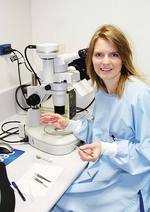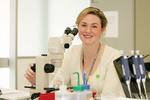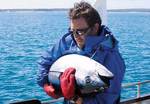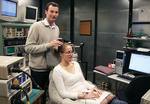Fresh Science
The University of Adelaide was strongly represented among the group of 16 young scientists chosen by Fresh Science in 2007. Fresh Science is a national program that identifies new and interesting research being done by early-career scientists around the country. It provides practical training and experience to the Fresh Scientists in how to present their research to the media and the public. Of the 16 Fresh Scientists selected for 2007 from more than 80 nominations, four were from the University of Adelaide: Quinn Fitzgibbon, Cadence Minge, Martin Sale and Edwina Sutton. You can find all of their research stories below. Fresh Science is sponsored by the Federal and Victorian governments. For more information, visit: www.scienceinpublic.com/sciencenow/
Brain gene flicks the switch on gender Biochemistry Biochemistry
University of Adelaide researchers have discovered a way of creating a male mouse without a Y chromosome by manipulating a single gene in the developing fetus. Normally males have one X and one Y chromosome and females have two X chromosomes. But Postdoctoral Research Officer Dr Edwina Sutton has produced male mice with two X chromosomes by artificially activating a gene in the developing gonads. "The gene - Sox3 on the X chromosome - is well known for its impact on brain development, but this is the first time it's ever been shown to change sexual development. By making this brain gene active in the developing gonads of mice with two X chromosomes during the critical stage of development, we switched off female development and switched on 'maleness'," said Dr Sutton. "This is not only important for our knowledge of evolution of the sex chromosomes, but it also has potentially significant implications for people with disorders of sexual development, the causes of which we know very little about. We can use these mice to increase our understanding of these disorders which occur with a high frequency in our community and, ultimately, develop therapies or technologies to improve clinical outcomes." This discovery came about by chance. Dr Sutton and her supervisor, Research Fellow Dr Paul Thomas, both in the University's School of Molecular and Biomedical Science, were investigating the role of Sox3 in brain development and discovered they had produced 80% XX male offspring. Although completely male in appearance, reproductive structures and behaviour, the XX males are all sterile. Dr Sutton's findings were recently presented at the First Pan American Congress in Developmental Biology in Cancun, Mexico.
'Fat eggs' likely cause of infertility in obese women Reproductive Health Reproductive Health
A University of Adelaide researcher has discovered scientific evidence that obesity is a key factor in infertility - because of how it affects women's eggs. While obesity has long been thought to be a major factor in couples' inability to conceive, this is the first time the effects of obesity on the egg have been discovered. The research findings - using female mice - have been made by PhD student Cadence Minge in the University of Adelaide's Research Centre for Reproductive Health. Importantly, her research has also discovered a way to completely reverse the effects of obesity on mouse eggs, enabling afflicted eggs to develop into healthy embryos. "Consuming a diet high in fat causes damage to eggs stored in female ovaries. As a result, when fertilised these eggs are not able to undergo normal, healthy development into embryos," Ms Minge said. Ms Minge has discovered that a protein in the cells surrounding, supporting and nourishing the egg - called Peroxisome Proliferator-Activated Receptor gamma (PPAR) - is the main reason behind diet-induced infertility. "The behaviour of this protein helps to determine the way in which the ovaries sense and respond to fats," Ms Minge said. "Being able to control this protein will be very important in the quest to reverse infertility caused by poor diets." Ms Minge's research has found that when the protein is selectively targeted with the anti-diabetes drug rosiglitazone (marketed as Avandia by GlaxoSmithKline), the adverse effects of obesity on egg quality are completely reversed.
"The drug enables us to switch on the protein, thereby changing the way in which the ovaries sense and respond to fats. Embryo development rates are restored, and the cellular differentiation of the early embryo is improved. In the long-term these improvements can result in increased birth weight and fetal survival," Ms Minge says. However, Ms Minge warns that rosiglitazone should not be seen as a "quick fix" for infertile women.
"The rosiglitazone findings are of great significance for scientists researching egg maturation within the ovary. But at this stage, the research findings have only been made in mice. Also, the drug itself can have possible harmful side-effects, and more research is needed to find other, safer ways of activating the protein," she said. "With more research, if we can pinpoint critical cellular controls of egg quality, it may allow women to maximise their likelihood of healthy conception." Ms Minge said her findings also emphasised the importance of a healthy lifestyle for women interested in conceiving children naturally. "Despite the wide-ranging recognised health risks associated with excessive bodyweight, Australia's waistline continues to expand. Currently, Australia is on par with heavyweight nations such as the US and the UK, with approximately 60% of Australian adults now overweight or obese," Ms Minge said. "I hope that these findings encourage people to carefully consider the impact of lifestyle choices on longer-term quality of life."
Tuna research adds value to industry Environmental Science Environmental Science
Bluefin tuna use three times as much oxygen as other fish their size, making them more difficult to culture, according to new research at the University of Adelaide. The findings have been made by Earth & Environmental Sciences PhD student Quinn Fitzgibbon and colleagues, in a study where they monitored live tuna swimming inside a 350-tonne "waterbed". The research team also found that tuna use twice as much energy processing their food as any other fish, and so need to eat more to grow. "Because of their high oxygen and energy demands, we think of tuna as the V8 race car of the fish community," Mr Fitzgibbon said. "Their large, finely tuned mechanisms support great performance, but use a lot of fuel and are expensive to run." While tuna farming has quickly grown to be Australia's most valuable aquaculture industry - worth about $300 million annually, mostly supplying the international sashimi market - until now little has been known about these large, strong fish because of the difficulties of studying them. The information the research team is collecting is being used in models that describe the energy needs of growing tuna. It will also help tuna farm managers ensure the health of their fish and assist in the design of feeding strategies, helping to maximize productivity and profitability. By installing a sealed bag or waterbed made from reinforced plastic into an ocean tuna farm, Mr Fitzgibbon was able to measure the consumption of oxygen of the tuna inside. Tuna are introduced to the waterbed through a sealable port and can spend weeks inside, happily swimming around and feeding. The bag has probes to measure oxygen levels in the water, video cameras to record the tuna's behaviour, and lights that turn on at night so filming need never stop. This innovative four-year research project has "opened a window on the unique physiology and ecology of this fascinating fish", Mr Fitzgibbon said. Mr Fitzgibbon has been working with scientists from South Australian Research and Development Institute (SARDI) Aquatic Sciences, and his work has been supported by the Aquafin CRC and its participants, including the Tuna Boat Owners Association of South Australia, the SA Government and Fisheries R&D Corporation.
Brains learn better at night Physiology Physiology
If you think that the idea of a morning person or an evening person is nonsense, then postgraduate student Martin Sale and his colleagues from the School of Molecular and Biomedical Science have news for you. They have found that the time of day influences your brain's ability to learn - and the human brain learns more effectively in the evening. By identifying at what point in the day the brain is best able to operate, rehabilitation therapy can be targeted to that time, when recovery is maximised. "Our research has several future applications," Mr Sale said. "If the brains of stroke patients can be artificially stimulated to improve learning, they may be able to recover better and faster." The researchers used a magnetic coil over the head to stimulate nerve activity in the brain, and linked it to an electrical stimulus of the hand.
Mr Sale discovered that the brain's capacity to control hand movements is influenced by the time of day. His study found that larger changes are induced when the experiments are performed in the evening, as compared with mornings. "Such time-of-day variations in function are not unusual. Organisms are adapted to the continual change in light and dark during a 24 hour period to avoid predators and to reproduce faster," he said. "For example, the petals of many flowers only open during the day, while some organisms only reproduce at night. In humans, these rhythms are governed by a variety of hormones that control many bodily functions."
|








